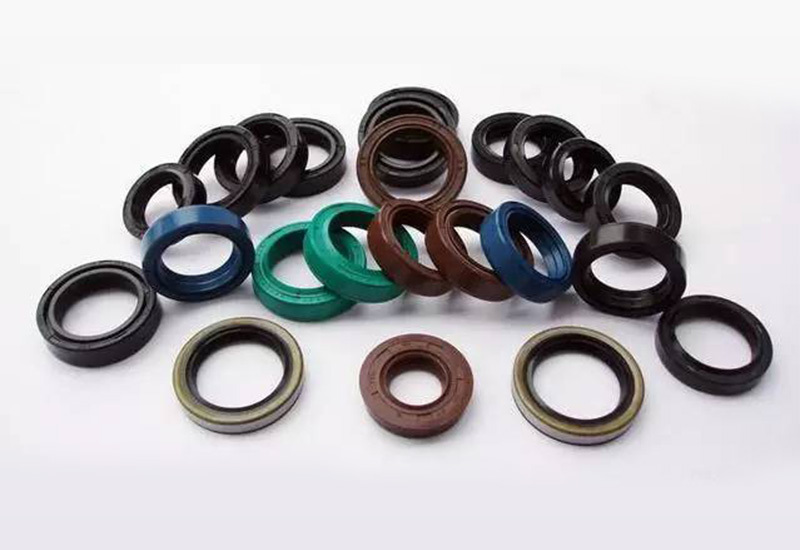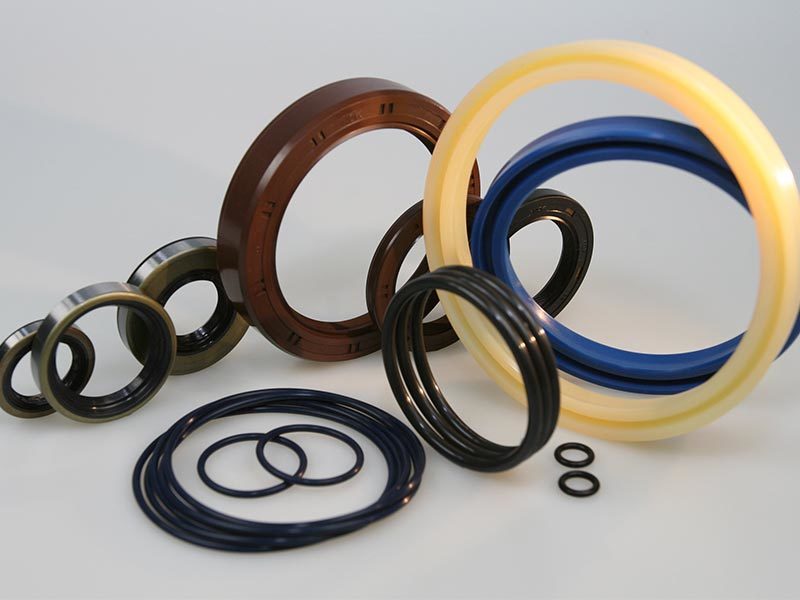Type and specialty of main rubber used in oil seal
Release time:
Feb 28,2024
The cold resistance of the oil seal is determined by important factors such as the characteristics of the lip material, the characteristics of the sealing medium, the eccentricity of the shaft, and the speed at start.
The oil seal is composed of rubber (lip part and matching part together), spring and metal frame.
1. Rubber
(1) Rubber type and general characteristics
Type and specialty of main rubber used in oil seal
|
Project Type |
oil resistance |
Alkali resistance |
Acid resistance |
Water resistance |
Weather resistance |
Wear resistance |
Temperature range (℃) |
specialty |
||
|
Minimum temperature |
Maximum temperature |
|||||||||
|
Nitrile Butadiene Rubber (NBR) |
◎ |
〇 |
〇 |
〇 |
△ |
◎ |
-40 |
125 |
Mineral oil resistance, good wear resistance, most used in oil seals. But can not be used in ketones and esters of polar solvents. |
|
|
Hydrogenated nitrile rubber (HNBR) |
◎ |
〇 |
〇 |
〇 |
〇 |
◎ |
-25 |
140 |
Maintain the characteristics of nitrile rubber seal, heat resistance, oil resistance and weather resistance nitrile rubber excellent. |
|
|
Acrylic rubber (ACM) |
◎ |
× |
△ |
△ |
◎ |
◎ |
-25 |
150 |
Maintain the same good oil resistance as nitrile rubber, heat resistance is slightly worse than silicone rubber, but excellent weather resistance, alkali resistance and water resistance than nitrile rubber and other rubber to be worse. |
|
|
Silicone Rubber (VMQ) |
〇 |
× |
△ |
△ |
◎ |
〇 |
-60 |
225 |
It has excellent heat resistance, cold resistance and weather resistance. But alkali resistance and water resistance than other rubber worse. |
|
|
Fluorine rubber (FKM) |
◎ |
△ |
〇 |
〇 |
◎ |
◎ |
-20 |
250 |
It has more heat resistance than silicone rubber, excellent oil resistance and chemical resistance. In all kinds of rubber, it is the best variety of rubber performance balance for oil seal. |
|
|
Ethylene |
× |
〇 |
〇 |
◎ |
◎ |
〇 |
-40 |
125 |
Rubber for oil seals with excellent water resistance, polar solvent resistance, inorganic chemical resistance and weather resistance. But the oil resistance is poor. |
|
|
Styrene-butadiene rubber (SBR) |
× |
〇 |
△ |
〇 |
△ |
◎ |
-45 |
100 |
Polar solvent resistance, excellent water resistance of oil seal rubber. But the oil resistance is poor. |
|
|
Polytetrafluoroethylene (PTFE) |
◎ |
◎ |
◎ |
◎ |
◎ |
◎ |
-65 |
260 |
Heat resistance, cold resistance, chemical resistance, weather resistance, the best, low friction coefficient of oil seal material. But the elasticity is worse than rubber. |
|
|
fiber |
◎ |
◎ |
◎ |
◎ |
◎ |
◎ |
-50 |
160 |
With synthetic fiber as the main raw material, than the felt material has always been heat resistance, resistance to loose excellent material. |
|
Remarks: ◎ have patience; ○ have patience except for specific occasions; △ have no patience except for specific occasions; × have no patience
High temperature-------
After 70 hours of air heating aging test, the tensile strength change rate is 30%, the elongation change rate is-50%, and the hardness change is within 15 degrees. The maximum temperature here is applicable to the heat resistance reference temperature for material evaluation specified in ASTM(American Society forTestingand Materials)D2000 Line Callouts of the American Society for Testing and Materials]]
Low temperature-------
TR is short for Temperature-Retraction (Retraction Temperature). Indicates recovery from deformation in low temperature areas as specified in ASTM D 1329. That is, the elastic recovery degree of the rubber elastic body is approximately the same.
The TR10 value is the temperature at which 10% of the predetermined deformation is recovered.
Cold resistance of oil seal
The cold resistance of the oil seal is determined by important factors such as the characteristics of the lip material, the characteristics of the sealing medium, the eccentricity of the shaft, and the speed at start.
Generally, for the eccentricity of the shaft and the% limit of the oil seal lip elongation, NOK is used in the low temperature field, and the TR10 value of the inner lip material is used as the reference for the allowable temperature. In an actual use state, for example, under a temperature condition lower than the TR10 value, there is also a case where heat is generated by sliding after starting, the temperature of the lip end rises, the rubber elasticity is restored, and the sealing property is maintained. On the other hand, under a temperature condition higher than the TR10 value, the eccentricity of the shaft becomes large, and the lip cannot follow the movement, so that leakage occurs in some cases. It is dangerous to determine the allowable temperature of the oil seal only by the TR10 value, and the above-mentioned important factors need to be considered.
Stability of various oils and chemical liquids:
|
Type of rubber Oil · Chemical |
Nitrile Rubber |
hydrogenated nitrile Rubber |
Acrylate Rubber |
Silicon Rubber |
Fluorine Rubber |
Ethylene Propylene Rubber |
Styrene-butadiene Rubber |
Teflon Ethylene |
||||
|
Engine Oil |
SAE#30 |
◎ |
◎ |
◎ |
◎ |
◎ |
× |
× |
◎ |
|||
|
SAE10W- #30 |
◎ |
◎ |
◎ |
〇 |
◎ |
× |
× |
◎ |
||||
|
gear oil |
For vehicles |
◎ |
◎ |
◎ |
△ |
〇 |
× |
× |
◎ |
|||
|
2 kinds of industrial (extreme pressure), synthetic base |
◎ |
◎ |
△ |
△ |
〇 |
△ |
△ |
◎ |
||||
|
Hydraulic torque converter oil · Automatic transmission oil |
◎ |
◎ |
◎ |
× |
〇 |
× |
× |
◎ |
||||
|
Brake oil |
DOT3 (alcohol type) |
△ |
× |
× |
〇 |
× |
〇 |
〇 |
◎ |
|||
|
DOT5 (alcohol type) |
△ |
× |
× |
〇 |
× |
〇 |
〇 |
◎ |
||||
|
DOT5 (Silicon Type) |
◎ |
◎ |
◎ |
× |
◎ |
× |
〇 |
◎ |
||||
|
Two kinds of turbine oil |
〇 |
〇 |
◎ |
△ |
◎ |
× |
× |
◎ |
||||
|
Machine oil (No. 2 spindle oil) |
〇 |
〇 |
〇 |
× |
◎ |
× |
× |
◎ |
||||
|
Hydraulic oil (mineral oil type) |
◎ |
◎ |
◎ |
△ |
◎ |
× |
× |
◎ |
||||
|
flame retardant hydraulic oil |
phosphate ester type |
× |
× |
× |
◎ |
△ |
× |
× |
◎ |
|||
|
water glycol type |
〇 |
〇 |
× |
△ |
△ |
× |
× |
◎ |
||||
|
cutting oil |
〇 |
◎ |
△ |
△ |
◎ |
× |
× |
◎ |
||||
|
Grease |
Mineral oil type |
◎ |
◎ |
◎ |
◎ |
◎ |
× |
× |
◎ |
|||
|
silicon base |
◎ |
◎ |
◎ |
× |
◎ |
× |
〇 |
◎ |
||||
|
fluorine group |
◎ |
◎ |
◎ |
◎ |
△ |
× |
× |
◎ |
||||
|
Refrigerant |
R12 paraffin type |
〇 |
◎ |
× |
× |
× |
× |
× |
◎ |
|||
|
R134a alcohol type |
△ |
〇 |
× |
× |
× |
◎ |
× |
◎ |
||||
|
Gasoline |
△ |
〇 |
× |
× |
◎ |
× |
× |
◎ |
||||
|
Light oil kerosene |
△ |
〇 |
× |
× |
◎ |
× |
× |
◎ |
||||
|
heavy oil |
〇 |
◎ |
△ |
× |
◎ |
× |
× |
◎ |
||||
|
Antifreeze (glycol type) |
〇 |
〇 |
× |
△ |
× |
◎ |
◎ |
◎ |
||||
|
Water · Warm Water |
〇 |
◎ |
× |
〇 |
〇 |
◎ |
◎ |
◎ |
||||
|
Sea water |
〇 |
◎ |
× |
× |
〇 |
◎ |
◎ |
◎ |
||||
|
water vapor |
× |
〇 |
× |
× |
× |
〇 |
△ |
◎ |
||||
|
10% hydrochloric acid solution |
〇 |
〇 |
〇 |
〇 |
〇 |
◎ |
〇 |
◎ |
||||
|
30% sulfuric acid solution |
△ |
△ |
△ |
× |
△ |
〇 |
△ |
◎ |
||||
|
10% nitric acid solution |
× |
△ |
× |
× |
△ |
〇 |
× |
◎ |
||||
|
40% sodium hydroxide solution |
〇 |
◎ |
× |
× |
× |
◎ |
◎ |
◎ |
||||
|
Benzene |
× |
× |
× |
× |
× |
× |
× |
◎ |
||||
|
Ethanol |
〇 |
〇 |
× |
〇 |
〇 |
◎ |
◎ |
◎ |
||||
|
Butanone |
× |
× |
× |
△ |
× |
× |
× |
◎ |
||||
|
Remarks: ◎ Have patience;〇Have patience except for specific occasions;△No patience except for specific occasions; ×No patience |
||||||||||||
(2) Types and main uses of NOK lip materials.
NOK uses all kinds of rubber described in (Table 1), and prepares all kinds of NOK lip materials for matching purposes. (Table 3) shows the types and main uses of NOK representative lip materials.
A variety of lip materials, in addition to the sealing effect (sealing) is excellent, but also to take into account the nature of the raw materials, with a good balance of technology.
In this way, when the nature of the lip material is obtained from the balance, the selection of good raw materials and chemical compounds, and the compounding technology becomes very important. In order to obtain the most suitable material for the oil seal, NOK has developed raw materials and mixed chemicals (additives) according to the sealing performance and basic research of various materials. These research results have played a role in improving the matching technology and making excellent lip materials.
Types and Main Uses of NOK Representative Lip Materials
|
NOK Lip Material
|
Hardness
|
Temperature range
|
Main use
|
Sealing medium
|
||||
|
Hs(JIS A)
|
(℃)
|
Mineral oil
|
Mud Water
|
Grease
|
||||
|
Types of rubber
|
Marker (color)
|
|
|
|||||
|
Nitrile Butadiene Rubber (NBR)
|
A727 (black)
|
70
|
-30 ~ 120
|
Standard materials (for solid conversion)
|
〇
|
|
〇
|
|
|
A941 (black)
|
80
|
-25 ~ 100
|
Standard material for medium and large diameter (shaft diameter exceeding 150mm) (for rotation)
|
〇
|
|
〇
|
||
|
A795 (black)
|
80
|
-11 ~ 100
|
Standard material (for reciprocating motion, pressure-resistant), fuel oil resistance
|
〇
|
|
〇
|
||
|
A275 (black)
|
70
|
-40 ~ 100
|
Cold resistance, weather resistance (for rotary)
|
〇
|
|
〇
|
||
|
A437 (black)
|
80
|
-40 ~ 100
|
Cold resistance (for reciprocating motion)
|
〇
|
〇
|
〇
|
||
|
A571 (black)
|
75
|
-25 ~ 100
|
Resistance to muddy water abrasion (for rotation)
|
|
〇
|
〇
|
||
|
A368 (black)
|
75
|
-20 ~ 100
|
Compliance with Food Hygiene Law (for rotary use)
|
|
|
〇
|
||
|
A989 (black)
|
70
|
-20 ~ 100
|
Special material (MO type)
|
〇
|
〇
|
〇
|
||
|
A103 (black)
|
70
|
-22 ~ 100
|
Water resistance (for rotary)
|
|
〇
|
|
||
|
Special Material (TCJ Type)
|
〇
|
|
〇
|
|||||
|
A104 (black)
|
80
|
-21 ~ 100
|
Special material (MG type)
|
〇
|
〇
|
〇
|
||
|
A134 (black)
|
60
|
-20 ~ 100
|
Special material (VR type)
|
|
〇
|
〇
|
||
|
Hydrogenated nitrile rubber (HNBR)
|
G418 (Black)
|
75
|
-25 ~ 130
|
Special material (for reciprocating motion)
|
〇
|
|
|
|
|
Acrylate
|
T303 (black)
|
80
|
-15 ~ 150
|
Standard material (for rotation)
|
〇
|
|
〇
|
|
|
Rubber (ACM)
|
T599 (black)
|
80
|
-25 ~ 140
|
Cold resistance (for rotation)
|
〇
|
|
〇
|
|
|
T302 (black)
|
80
|
-15 ~ 150
|
Special Material (TCJ Type)
|
〇
|
|
〇
|
||
|
Silicone Rubber (VMQ)
|
S728 (black)
|
80
|
-45 ~ 170
|
Standard material (for rotation)
|
〇
|
|
|
|
|
S817 (white)
|
75
|
-45 ~ 170
|
Compliance with Food Hygiene Law (for rotary use)
|
|
|
〇
|
||
|
Fluorine rubber (FKM)
|
F585 (brown)
|
75
|
-15 ~ 200
|
Standard material (for rotation)
|
〇
|
|
〇
|
|
|
F975 (brown)
|
80
|
-15 ~ 200
|
Special material (for reciprocating motion)
|
〇
|
|
〇
|
||
|
F548 (black)
|
85
|
-16 ~ 200
|
Pressure resistance (for rotation)
|
〇
|
|
〇
|
||
|
F129 (black)
|
70
|
-15 ~ 200
|
Special material (VR type)
|
|
|
〇
|
||
|
Polytetrafluoroethylene resin (PTFE)
|
31BF (Black)
|
Douro hardness
|
-50 ~ 220
|
Special Material (Type J), Chemical Resistance, Heat Resistance, Low Friction
|
〇
|
|
〇
|
|
|
D 65
|
||||||||
|
40WF (white)
|
|
Compliance with Food Hygiene Law (for rotary use)
|
|
|
〇
|
|||
|
fiber
|
31FH (Black)
|
�
|
-50 ~ 160
|
Material for dust lips, ventilation
|
--
|
|||
Note (1): In addition to the lip materials shown, there are ethylene-propylene rubber, styrene-butadiene rubber, etc. for special purposes.
Note (2): The temperature range in the table applies to the following standards
In terms of high temperature · · · The temperature standard that can be used in terms of the function of the oil seal.
For low temperature, TR10 value is applicable to lip material.
Note (3): For details of the sealing medium resistance of various lip materials, please consult our technical personnel.
Note (4): The use of fluororubber in the listed NOK lip materials is for aircraft, artificial satellites and other space development vehicles, which are strategic goods (or labor) under foreign exchange and foreign trade management laws and must be exported under the same regulations.
The table above summarizes the various tolerance and temperature ranges. In case of problems in actual use, please contact our technical personnel, we will try our best to help you solve the problem. Especially because the temperature is affected by the type of sealing medium and working conditions during use, the function of the oil seal must be paid attention. When rubber is affected by temperature, the polymer of rubber is cut off by heat or heat with oil, chemicals, ozone, etc. at high temperature, and the bond is excessively increased, the rubber elasticity is lost, and chemical changes are produced. The use temperature is determined according to the correlation between temperature and time. If there is only a short time high temperature, from the long-term consideration, the use of lower temperature.
On the other hand, at a low temperature, the polymer constituting the rubber loses its activity, and the hardness changes. This phenomenon is a reversible physical change that roughly varies with temperature. Even if repeated low temperature-room temperature cycle, the elasticity of rubber can still be maintained at room temperature.
Key words:
Learn More About Industry Dynamics
In the face of fierce market competition, the company strives to develop, strive to speed up the optimization and upgrading of product structure, strengthen technological transformation, strictly abide by the requirements of the ISO9001 quality management system, establish a modern enterprise management system, and improve economic efficiency.

Professional manufacturer of automotive seals
Contact Us
Address: Julu Xijiantai Industrial Zone, Hebei Province
Telephone:+8613473199214
Fax:0086-319-4395069
Mailbox:xinghua@juluxinghua.com
Website:en.juluxinghua.com
Quality of service to win customer satisfaction

Scan code to browse the official website
Learn more about auto parts at any time
Leave us a message.









